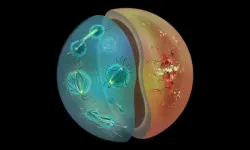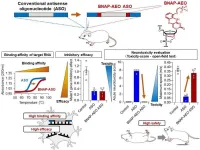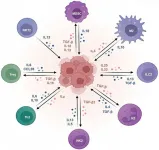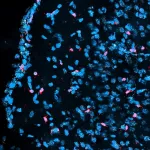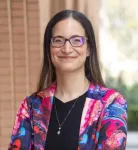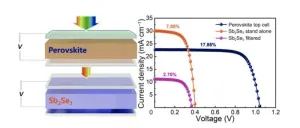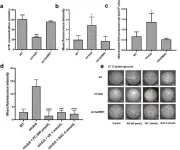(Press-News.org) Cell division is one of the most fundamental processes of life. From bacteria to blue whales, every living being on Earth relies on cell division for growth, reproduction, and species survival. Yet, there is remarkable diversity in the way different organisms carry out this universal process. A new study from EMBL Heidelberg’s Dey group and their collaborators, recently published in Nature, explores how different modes of cell division evolved in close relatives of fungi and animals, demonstrating, for the first time, the link between an organism’s life cycle and the way their cells divide.
Despite last sharing a common ancestor over a billion years ago, animals and fungi are similar in many ways. Both belong to a broader group called ‘eukaryotes’ – organisms whose cells store their genetic material inside a closed compartment called the ‘nucleus’. The two differ, however, in how they carry out many physiological processes, including the most common type of cell division – mitosis.
Most animal cells undergo ‘open’ mitosis, in which the nuclear envelope – the two-layered membrane separating the nucleus from the rest of the cell – breaks down when cell division begins. However, most fungi use a different form of cell division – called ‘closed’ mitosis – in which the nuclear envelope remains intact throughout the division process. However, very little is known about why or how these two distinct modes of cell division evolved and what factors determine which mode would be predominantly followed by a particular species.
This question captured the attention of scientists in the Dey Group at EMBL Heidelberg, who investigate the evolutionary origins of the nucleus and cell division. “By studying diversity across organisms and reconstructing how things evolved, we can begin to ask if there are universal rules that underlie how such fundamental biological processes work,” said Gautam Dey, Group Leader at EMBL Heidelberg.
In 2020, during the COVID-19 lockdown, an unexpected path to answering this question grew out of discussions between Dey’s group and Omaya Dudin’s team at the Swiss Federal Institute of Technology (EPFL), Lausanne. Dudin is an expert in an unusual group of marine protists – Ichthyosporea. Ichthyosporea are closely related to both fungi and animals, with different species lying closer to one or the other group on the evolutionary family tree.
The Dey and Dudin groups, in collaboration with Yannick Schwab’s group at EMBL Heidelberg, decided to probe the origins of open and closed mitosis using Ichthyosporea as a model. Interestingly, the researchers found that certain species of Ichthyosporea undergo closed mitosis while others undergo open mitosis. Therefore, by comparing and contrasting their biology, they could obtain insights into how organisms adapt to and use these two cell division modes.
Hiral Shah, an EIPOD fellow working across the three groups, led the study. “Having recognised very early that Ichthyosporea, with their many nuclei and key evolutionary position between animal and fungi, were well-suited for addressing this question, it was clear that this would require bringing together the cell biological and technical expertise of the Dey, Dudin, and Schwab groups, and this is exactly what the EIPOD fellowship allowed me to do,” said Shah.
Upon closely probing the mechanisms of cell division in two species of Ichthyosporeans, the researchers found that one species, S. arctica, favours closed mitosis, similar to fungi. S. arctica also has a life cycle with a multinucleate stage, where many nuclei exist within the same cell – another feature shared with many fungal species as well as the embryonic stages of certain animals, such as fruit flies. Another species, C. perkinsii, turned out to be much more animal-like, relying on open mitosis. Its life cycle involves primarily mononucleate stages, where each cell has a single nucleus.
“Our findings led to the key inference that the way animal cells do mitosis evolved hundreds of millions of years before animals did. The work therefore has direct implications for our general understanding of how eukaryotic cell division mechanisms evolve and diversify in the context of diverse life cycles, and provides a key piece of the animal origins puzzle,” said Dey.
The study combined expertise in comparative phylogenetics, electron microscopy (from the Schwab Group and the electron microscopy core facility (EMCF) at EMBL Heidelberg), and ultrastructure expansion microscopy, a technique that involves embedding biological samples in a transparent gel and physically expanding it. Additionally, Eelco Tromer, from the University of Groningen in the Netherlands, and Iva Tolic, from the Ruđer Bošković Institute in Zagreb, Croatia, provided expertise in comparative genomics and mitotic spindle geometry and biophysics, respectively.
“The first time we saw an expanded S. arctica nucleus, we knew this technique would change the way we study the cell biology of non-model organisms,” said Shah, who brought back the expansion microscopy technique to EMBL Heidelberg after a stint at the Dudin lab. Dey agrees: “A key breakthrough in this study came with our application of ultrastructure expansion microscopy (U-ExM) to the analysis of the ichthyosporean cytoskeleton. Without U-ExM, immunofluorescence and most dye labelling protocols do not work in this understudied group of marine holozoans.”
This study also demonstrates the importance of going beyond traditional model organism research when trying to answer broad biological questions, and the potential insights further research on Ichthyosporean systems might reveal. “Ichthyosporean development displays remarkable diversity,” said Dudin. “On one hand, several species exhibit developmental patterns similar to those of early insect embryos, featuring multinucleated stages and synchronised cellularisation. On the other hand, C. perkinsii undergoes cleavage division, symmetry breaking, and forms multicellular colonies with distinct cell types, similar to the ‘canonical view’ of early animal embryos. This diversity not only helps in understanding the path to animals but also offers a fascinating opportunity for comparative embryology outside of animals, which is, in itself, very exciting.”
The project’s inherent interdisciplinarity served not only as a good testbed for this type of collaborative research but also for the unique postdoctoral training afforded at EMBL. “Hiral’s project nicely illustrates the virtue of the EIPOD programme: a truly interdisciplinary project, bundling innovative biology with advanced methods, all contributing to a truly spectacular personal development,” said Schwab. “We (as mentors) witnessed the birth of a strong scientist, and this is really rewarding!”
The Dey, Dudin, and Schwab groups are currently also collaborating on the PlanExM project, part of the TREC expedition – an EMBL-led initiative to explore and sample the biodiversity along European coasts. PlanExM aims to apply expansion microscopy to study the ultrastructural diversity of marine protists directly in environmental samples. “The project grew out of the realisation that U-ExM is going to be a game-changer for protistology and marine microbiology,” said Dey. With this project, as well as others currently underway, the research team hopes to shed further light on the diversity of life on Earth and the evolution of the fundamental biological processes.
END
Exploring diversity in cell division
New research by EMBL scientists shows how different modes of cell division used by animals and fungi might have evolved to support diverse life cycles
2024-05-22
ELSE PRESS RELEASES FROM THIS DATE:
Sweet move: a modified sugar enhances antisense oligonucleotide safety and efficacy
2024-05-22
Researchers from Tokyo Medical and Dental University (TMDU) and Osaka University find that a newly developed modified sugar increases the efficacy and safety of antisense oligonucleotides designed to treat central nervous system disease
Tokyo, Japan – Diseases that affect the brain and spinal cord can be particularly devastating, and finding new and more effective ways to treat these conditions is an important goal for researchers and clinicians alike. Now, a research group from Japan reports that slightly modifying an existing treatment for central nervous system (CNS) disease dramatically increases its ...
Treatment options for hepatocellular carcinoma using immunotherapy: present and future
2024-05-22
Hepatocellular carcinoma (HCC), a prevalent form of cancer, profoundly influences the progression and prognosis of the disease through immune response mechanisms. The tumor microenvironment plays a pivotal role in fostering immune suppression and maintaining self-tolerance, which are crucial in developing and refining immunotherapy approaches.
In our comprehensive review, we initially delve into the characteristics of the tumor microenvironment in HCC, elucidating the predominant immunosuppressive mechanisms at play and the biomarkers pivotal for tracking the disease progression and therapeutic ...
Chevron partners with the Geological Society of America to offer geology field trip grants to students and early career professionals
2024-05-22
Boulder, Colo., USA: Chevron, a leading energy corporation committed to supporting educational initiatives in the geosciences, has announced a partnership with the Geological Society of America (GSA) to provide field trip grants, beginning with the organization’s annual meeting, GSA Connects 2024. This year’s meeting will take place in Anaheim, California, USA, 22–25 September.
The GSA/Chevron Field Trip Grant aims to support students or early career professionals in attending field trips during GSA Connects. GSA’s field trips provide valuable hands-on learning experiences, networking opportunities, ...
Nearly 3% of healthy adolescents use commercial CBD products, study finds
2024-05-22
Since cannabidiol (CBD), the non-intoxicating component of cannabis, was legalized in the United States by the 2018 Farm Bill, products containing the compound have flooded the consumer health sector. While there is a single FDA-approved medication containing CBD which can be used to treat rare forms of epilepsy, evidence for the efficacy of commercial CBD products, which generally contain low doses of CBD, is limited. However, this has not stopped their widespread and growing use.
Now, a new study published in Cannabis ...
Mimicking infection in pregnant mice provokes persistent changes in juvenile brains
2024-05-22
No parent wants to risk their child having a serious infection, least of all while still in the womb, but did you know that the immune response to a viral infection during pregnancy could also affect the development of the unborn offspring? Scientists from Harvard University in Cambridge, USA, have shown that immune reactions in pregnant mice are detected by a specific type of brain cell in the developing embryo and alter how genes are regulated in the brain – a change that persists in juvenile mice. Published today in the journal Development, this study provides ...
New study highlights significant increases in cannabis use in United States
2024-05-22
Many countries around the world are considering revising cannabis policies. A new study by a researcher at Carnegie Mellon University assessed cannabis use in the United States between 1979 and 2022, finding that a growing share of cannabis consumers report daily or near-daily use and that their numbers now exceed those of daily and near-daily alcohol drinkers. The study concludes that long-term trends in cannabis use parallel corresponding changes in policy over the same period. The study appears in Addiction.
“The data come from survey self-reports, but the enormous changes in ...
Bérénice Benayoun (USC) receives Rising Star Award in Aging Research
2024-05-22
New York, NY – The American Federation for Aging Research (AFAR), a national non-profit organization whose mission is to support and advance healthy aging through biomedical research, is pleased to recognize the exemplary contributions of Bérénice Benayoun, PhD, to the field of aging research through the 2024 Vincent Cristofalo Rising Star Award in Aging Research.
This award is named in honor of the late Dr. Cristofalo, who dedicated his career to aging research and encouraged young scientists to investigate important issues in the biology of aging. Established in 2008, the award ...
Team fabricates tandem solar cell with power conversion efficiency greater than 20 percent
2024-05-22
A research team has demonstrated for the first time a proof-of-concept tandem solar cell using antimony selenide as the bottom cell material and a wide-bandgap organic–inorganic hybrid perovskite material as the top cell material. The device achieved a power conversion efficiency of over 20 percent. This study shows that antimony selenide has great potential for bottom cell applications.
The research is published in the journal Energy Materials and Devices on March 4, 2024.
Photovoltaic technology, that harnesses sunlight and converts it into electricity, is popular because it provides a clean, renewable energy source. Scientists ...
Mitochondrial phosphate carrier plays an important role in virulence of Candida albicans
2024-05-22
This study is led by Professor Yan Wang (School of Pharmacy, Second Military Medical University (Naval Medical University), Shanghai, China). Her team found that the lack of MIR1 gene, which encodes mitochondrial phosphate carrier, can lead to severe virulence defects in Candida albicans.
In the Caenorhabditis elegans candidiasis model, the survival rate of the wild-type strain infected group dropped to about 20% at 120 h, while the survival rate of the mir1Δ/Δ-infected group remained about 90% at 120 h. Similar results were obtained in the murine model. None of the mice infected with mir1Δ/Δ mutant died during 21 days of ...
Enhanced plasticity of spontaneous coagulation cast oxide ceramic green bodies
2024-05-22
Spontaneous coagulation casting (SCC), a new type of colloidal forming process, has garnered significant attention since 2011 due to various advantages of a high bulk density and non-toxicity, as well as the ability to achieve dispersion and coagulation with very low additions (< 1 wt%) of copolymers of isobutylene and maleic anhydride (PIBM). Further research has revealed that the green bodies formed by this method are brittle, and the smaller the powder particle size used the more brittle the green bodies are. This paper reports ...
LAST 30 PRESS RELEASES:
Drone sampling of whale breath reveals first evidence of potentially deadly virus in Arctic
Roman soldiers defending Hadrian’s Wall infected by parasites, study finds
Pinochet’s prisoners were tormented with music but still found solace in it, a new book reveals
Fertility remains high in rural Tanzania despite access to family planning
AI-assisted device can improve autism care access
Kinetic careers
Uncovering how parasitic plants avoid attacking themselves to improve crop resistance
Nanoparticle vaccine strategy could protect against Ebola and other deadly filoviruses
Study finds brain care score can predict risk of stroke across racial groups
Key lung immune cells can intensify allergic reactions
Do hormones explain why women experience more gut pain?
New materials conduct ions in solids as easily as in liquids
Breakthrough of the Year: Renewable energy begins to eclipse fossil fuel-based sources
LLM use is reshaping scientific enterprise by increasing output, reducing quality and more
Introducing LightGen, a chip for ultra-fast, ultra-efficient generative AI
Astronomers see fireworks from violent collisions around nearby star
ACC/AHA issue new guideline on managing congenital heart disease in adults
Cosmic crash caught on camera
Is talented youth nurtured the wrong way? New study shows: top performers develop differently than assumed
Ants: An untapped resource in the development of antibiotics?
Archaeologists use AI to create prehistoric video game
Mitochondria migrate toward the cell membrane in response to high glucose levels
Tiny viral switch offers hope against drug-resistant bacteria
Most parents aware of early peanut introduction guidelines, but confused about details
HPV vaccine can protect against severe lesions of the vulva and vagina
Virtual care provision and emergency department use among children and youth
Quadrivalent HPV vaccine and high-grade vulvovaginal lesions
Insights into dry eyes gained from stem cell-derived tear glands
Researchers identify 166 human pluripotent stem cell lines available for use in clinical applications
Europa Clipper instrument uniquely observed interstellar comet 3I/ATLAS
[Press-News.org] Exploring diversity in cell divisionNew research by EMBL scientists shows how different modes of cell division used by animals and fungi might have evolved to support diverse life cycles
